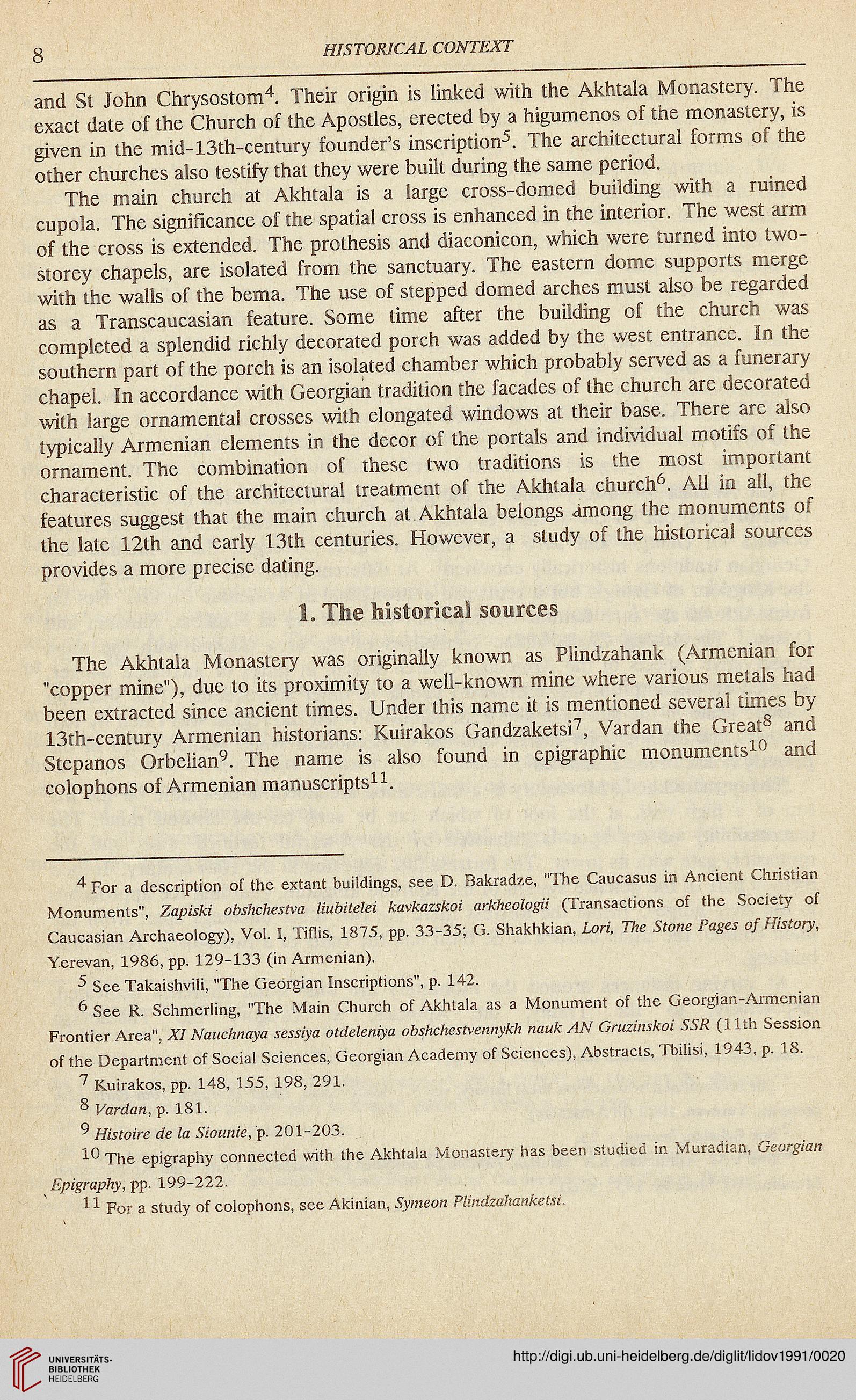8
wxrop/CAL crw/PAr
and St John Chrysostom^. Their origin is linked with the Akhtaia Monastery. The
exact date of the Church of the Aposties, erected by a higumenos of the monastery, is
given in the mid-13th-century founder's inscription^. The architecturai forms of the
other churches aiso testify that they were buiit during the same period.
The main church at Akhtaia is a iarge cross-domed buiiding with a ruined
cupoia. The significance of the spatiai cross is enhanced in the interior. The west arm
of the cross is extended. The prothesis and diaconicon, which were turned into two-
storey chapeis, are isolated from the sanctuary. The eastern dome supports merge
with the walls of the bema. The use of stepped domed arches must also be regarded
as a Transcaucasian feature. Some time after the building of the church was
completed a splendid richly decorated porch was added by the west entrance. In the
southern part of the porch is an isolated chamber which probably served as a funerary
chapel. In accordance with Georgian tradition the facades of the church are decorated
with large ornamental crosses with elongated windows at their base. There are also
typically Armenian elements in the decor of the portals and individual motifs of the
ornament. The combination of these two traditions is the most important
characteristic of the architectural treatment of the Akhtaia church^. All in all, the
features suggest that the main church at Akhtaia belongs among the monuments of
the late 12th and early 13th centuries. However, a study of the historical sources
provides a more precise dating.
1. The historical sources
The Akhtaia Monastery was originally known as Plindzahank (Armenian for
"copper mine"), due to its proximity to a well-known mine where various metals had
been extracted since ancient times. Under this name it is mentioned several times by
13th-century Armenian historians: Kuirakos Gandzaketsi*?, Vardan the Greats and
Stepanos OrbelianT The name is also found in epigraphic monuments^ and
colophons of Armenian manuscripts^.
4 For a description of the extant buiidings, see D. Bakradze, "The Caucasus in Ancient Christian
Monuments", Za/Mrk: obr7;cAcrtva 77a67telc7 kavkazrko; arkAeoIogA (Transactions of the Society of
Caucasian Archaeoiogy), Voi. I, Titlis, 1873, pp. 33-33; G. Shakhkian, Tor;, 7/;e 3?one Pager o/77/rtory,
Yerevan, 1986, pp. 129-133 (in Armenian).
^ See Takaishviii, "The Georgian Inscriptions", p. 142.
6 See R. Schmeriing, "The Main Church of Akhtaia as a Monument of the Georgian-Armenian
Frontier Area", A/ JVaacAaaya rernya otdefeaTya obrAcAerO'eaayAA naakATV Graz/a.skot 337? (11th Session
of the Department of Social Sciences, Georgian Academy of Sciences), Abstracts, Tbilisi, 1943, p. 18.
7 Kuirakos, pp. 148, 133, 198, 291.
8 Fardaa, p. 181.
7 77/rtoae de 7a 37oaa7e, p. 201-203.
^0 The epigraphy connected with the Akhtaia Monastery has been studied in Muradian, Ceorgfan
EpfgrapAy, pp. 199-222.
For a study of colophons, see Akinian, 3ya:eoa P/tadzafazakcfr;'.
wxrop/CAL crw/PAr
and St John Chrysostom^. Their origin is linked with the Akhtaia Monastery. The
exact date of the Church of the Aposties, erected by a higumenos of the monastery, is
given in the mid-13th-century founder's inscription^. The architecturai forms of the
other churches aiso testify that they were buiit during the same period.
The main church at Akhtaia is a iarge cross-domed buiiding with a ruined
cupoia. The significance of the spatiai cross is enhanced in the interior. The west arm
of the cross is extended. The prothesis and diaconicon, which were turned into two-
storey chapeis, are isolated from the sanctuary. The eastern dome supports merge
with the walls of the bema. The use of stepped domed arches must also be regarded
as a Transcaucasian feature. Some time after the building of the church was
completed a splendid richly decorated porch was added by the west entrance. In the
southern part of the porch is an isolated chamber which probably served as a funerary
chapel. In accordance with Georgian tradition the facades of the church are decorated
with large ornamental crosses with elongated windows at their base. There are also
typically Armenian elements in the decor of the portals and individual motifs of the
ornament. The combination of these two traditions is the most important
characteristic of the architectural treatment of the Akhtaia church^. All in all, the
features suggest that the main church at Akhtaia belongs among the monuments of
the late 12th and early 13th centuries. However, a study of the historical sources
provides a more precise dating.
1. The historical sources
The Akhtaia Monastery was originally known as Plindzahank (Armenian for
"copper mine"), due to its proximity to a well-known mine where various metals had
been extracted since ancient times. Under this name it is mentioned several times by
13th-century Armenian historians: Kuirakos Gandzaketsi*?, Vardan the Greats and
Stepanos OrbelianT The name is also found in epigraphic monuments^ and
colophons of Armenian manuscripts^.
4 For a description of the extant buiidings, see D. Bakradze, "The Caucasus in Ancient Christian
Monuments", Za/Mrk: obr7;cAcrtva 77a67telc7 kavkazrko; arkAeoIogA (Transactions of the Society of
Caucasian Archaeoiogy), Voi. I, Titlis, 1873, pp. 33-33; G. Shakhkian, Tor;, 7/;e 3?one Pager o/77/rtory,
Yerevan, 1986, pp. 129-133 (in Armenian).
^ See Takaishviii, "The Georgian Inscriptions", p. 142.
6 See R. Schmeriing, "The Main Church of Akhtaia as a Monument of the Georgian-Armenian
Frontier Area", A/ JVaacAaaya rernya otdefeaTya obrAcAerO'eaayAA naakATV Graz/a.skot 337? (11th Session
of the Department of Social Sciences, Georgian Academy of Sciences), Abstracts, Tbilisi, 1943, p. 18.
7 Kuirakos, pp. 148, 133, 198, 291.
8 Fardaa, p. 181.
7 77/rtoae de 7a 37oaa7e, p. 201-203.
^0 The epigraphy connected with the Akhtaia Monastery has been studied in Muradian, Ceorgfan
EpfgrapAy, pp. 199-222.
For a study of colophons, see Akinian, 3ya:eoa P/tadzafazakcfr;'.





